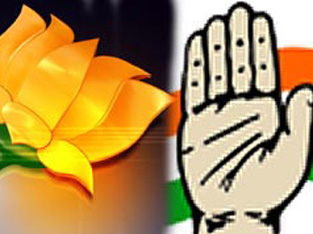BJP rejects Planning Commission's poverty ratio claim, BJP,Lok Sabha News, Lok sabha , Latest News, Latest political news, Latest and Breaking News, Breaking News.
- Details
- Category: National Political News
- Last Updated: Thursday, 22 January 2015 20:46
| BJP rejects Planning Commission's poverty ratio claim, BJP,Lok Sabha News, Lok sabha , Latest News, Latest political news, Latest and Breaking News, Breaking News. |
|
New Delhi:
The Bharatiya Janata Party on Tuesday slammed the UPA government's claim that India's poverty ratio has declined to 21.9 per cent in 2011-12 from 37.2 per cent in 2004-2005. The BJP accused the government of lowering the bar on the definition of poverty and attempting to mislead the people of India by spinning the new figures as an achievement. "If you change the definition of poor, then poverty will reduce. It depends how the poor are perceived," said BJP leader Murli Manohar Joshi. The Planning Commission had on Tuesday said the decline in poverty is mainly on account of rising real per capita consumption figures, but the BJP rejected the government's claims that people whose consumption of goods and services exceeded Rs 33 in cities and 27 per capita per day in villages were not considered poor. According to the Commission, in 2011-12 for rural areas, the national poverty line by using the Tendulkar methodology is estimated at Rs 816 per capita per month in villages and Rs 1,000 per capita per month in cities. This would mean that the persons whose consumption of goods and services exceed Rs 33.33 in cities and Rs 27.20 per capita per day in villages are not poor. The Commission said that for a family of five, the all India poverty line in terms of consumption expenditure would amount to Rs 4,080 per month in rural areas and Rs 5,000 per month in urban areas. The poverty line however will vary from state to state. The percentage of persons below poverty line in 2011-12 has been estimated at 25.7 per cent in rural areas, 13.7 per cent in urban areas and 21.9 per cent for the country as a whole, a Commission's press statement said. The percentage of persons below poverty line in 2004-05 was 41.8 per cent in rural areas, 25.7 per cent in cities and 37.2 per cent in the country as a whole. In actual terms, there were 26.93 crore people below poverty line in 2011-12 as compared to 40.71 crore in 2004-05. This ratio for 2011-12 which is based on the methodology suggested by Suresh Tendulkar Committee, factors in money spent on health and education besides calorie intake to fix a poverty line. The Commission said the decline in poverty is mainly on account of rising real per capita consumption figures which is based on 68th round of National Sample Survey on Household Consumer Expenditure in India in 2011-12. Earlier, a committee was appointed under Prime Minister's Economic Advisory Council Chairman C Rangarajan to revisit the Tendulkar Committee methodology for tabulating poverty. The Committee is expected to submit its report by mid 2014. State-wise, the Commission said the poverty ratio was highest in Chhattisgarh at 39.93 per cent followed by Jharkhand (36.96 per cent), Manipur (36.89 per cent), Arunachal Pradesh (34.67 per cent) and Bihar (33.47 per cent). Among the union territories, the Dadra and Nagar Haveli was the highest, with 39.31 per cent people living below poverty line followed by Chandigarh at 21.81 per cent. Goa has the least percentage of people living below poverty line at 5.09 per cent followed by Kerala (7.05 per cent), Himachal Pradesh (8.06 per cent), Sikkim (8.19 per cent), Punjab (8.26 per cent) and Andhra Pradesh (9.20 per cent). source:http://ibnlive.in.com/ |



